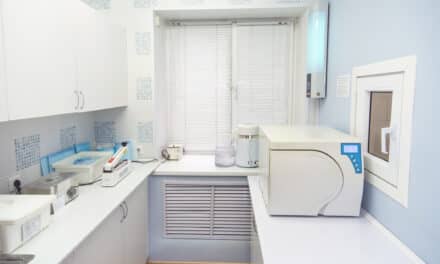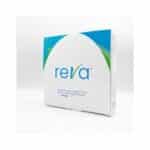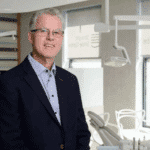Over the past few years, infection control standards and universal precautions have generally stayed the same while technology advances. In fact, when it comes down to it, the requirements for infection prevention/sterilization set out by the Centers for Disease Control and Prevention (CDC) in the past two decades have not changed much. But the same can not be said about the technology used to meet those requirements. While the autoclave remains the gold standard in dental sterilization, and dry heat another safe and convenient option, ultraviolet light offers the dental space an intriguing alternative that can go a long way to increasing practice productivity while doing the same job only faster.
To understand the possibilities that UV light offers dental sterilization, one doesn’t need to look far. The medical field provides a window into the possibilities.
The medical field is always trying to limit the number of healthcare-associated pathogens that are facility born. As such, newer ultraviolet light disinfection systems such as UV-C, pulsed-xenon UV light, and high-intensity narrow-spectrum UV light have recently been shown to reduce the number of these harmful infectious agents. Currently, in the medical field, UV light is used in a variety of settings such as hospital waiting rooms, operating rooms, and in/out patient rooms.
So why is this technology potentially attractive to an orthodontic practice? Because it is effective and more efficient. As already stated, UV light as a sterilization method is widely used in real-world medical settings. Day in and day out, the technology proves its effectiveness in controlling healthcare-associated pathogens. But we also offer our own research* to back up our contention that UV light is effective and efficient and has a role to play in the orthodontic practice. Our study found huge reductions in both sterilization time and cost—40% and 1,425%, respectively. From the perspective of fiscal responsibility, it is hard to argue against pursuing this technology.
What is UV light?
Ultraviolet light first received notice in 1903 when Niels Finsen won the Nobel Prize for medicine for his work using UV light as a means of combating tuberculosis. Ultraviolet light wavelength comes in three different categories: UV-A, UV-B, and UV-C. The most important one to the medical and dental field is UV-C which is the germicidal wavelength. This short wavelength form of UV light kills microorganisms by way of destroying the nucleic acids and breaking apart germ DNA.
The UV light differs from traditional autoclave and dry heat sterilization units in a number of ways. First, UV light sterilization has no chance of forming rust since UV light does not use any heat or steam and remains dry during the entire sterilization cycle. Second, as UV light does not create any heat, there is no cool-down time which allows faster sterilization time. Third, capitalizing on the fact that UV light does not produce heat during the sterilization process, the orthodontic office is able to safely clean different types of instruments, especially non-metal objects, that are often not compatible with the more conventional methods of sterilization that involve high temperatures. As clinical orthodontics utilizes a number of plastic/acrylic instruments—think of all of our retractors—this is a perfect sterilizing medium.
What did we do to test the effectiveness of UV light?
Faster Pre-sterilization
While we wait for ultraviolet light sterilization to become a reality, the pre-sterilization procedures used in this study have been proven to be not only effective but much faster than conventional methods. The biggest difference in the pre-sterilization protocol is the type of instruments used to clean the molar bands and the length of time in cold sterilization prior to placement in a dry heat unit. Following the pre-sterilization procedure noted below in conjunction with your current method of sterilization will improve effectiveness and efficiency while saving both time and money.
1. Clean off molar bands using a test tube brush that was previously soaked in Ortho-Clean®
2. Dip the molar band into Ortho-Clean cleaning solution for 10 seconds
3. Rinse with distilled water for 10 seconds.
In our study…
We looked at something every orthodontist does every day: sterilizing fitted but unused molar bands. We chose to look at molar bands because after sizing and pre-fitting, they are often contaminated with blood and oral debris. We then pitted a UV light sterilizing unit against a dry heat sterilizer to sterilize 40 molar bands, 20 in each group.
Various staff members were given five bands each and instructed to put them in their mouths and swish them around for 30 seconds in order to contaminate them with any bacteria elicited from blood, saliva, oral fluids, and/or other debris. We then proceeded to sterilize each group according to the following steps.
For the dry heat group, we:
- Cleaned off molar bands using a conventional instrument brush under filtered tap water
- Submerged molar bands in Ortho-Clean® (Sodium Gluconate, Sodium Bicarbonate) multi-purpose ultrasonic cleaning solution (G&H Orthodontics®) for 30 minutes
- Rinsed with filtered tap water
- Placed into a dry sterilization unit for 60 minutes
- Allowed bands to cool down for 10 minutes
- Sorted and then placed each band in its appropriate size compartment within the main clinic band box.
For the UV group, we:
- Cleaned off molar bands using a test tube brush that was previously soaked in Ortho-Clean
- Dipped the molar band into Ortho-Clean cleaning solution for 10 seconds
- Rinsed with distilled water for 10 seconds
- Placed the bands in custom made clear band box tray according to its numbered size
- Placed clear band box tray into ultraviolet sterilization unit for 60 minutes
To test the effectiveness of each method of sterilization, we placed each band in a sterile test tube containing brain heart infusion and sent it to our Microbiology Department (New York University) for incubation after which each band was tested for any bacterial growth.
The results showed that both the dry heat and ultraviolet light were identical. Both methods achieved a 95% success rate (19 out of 20). When we looked at each band that failed, we discovered that the bacterial growth that occurred resulting from dry heat sterilization was more virulent than the growth occurring from ultraviolet light sterilization. When time was considered, the UV light sterilized the molar bands 40% faster.
Considering the fact that the results of each sterilization method were the same, we are left to ask why wouldn’t a practitioner choose the faster and more cost-effective option? By embracing newer technology, a practitioner can boost profit margins and dedicate less staff time to sterilization. This then frees up staff time, giving more time to other necessary tasks, benefiting the practice overall.
A final consideration is the cost difference. For this study, we used the Salon Sundry Professional Tabletop Ultraviolet UV Sterilizer Cabinet and the Wayne Metal Products s1000 Dry Heat Sterilizer. The difference in cost: The UV sterilization unit was 1/14th the cost of the dry heat device used. While the UV light sterilizer we used for this study is not FDA approved, it served our needs. But more importantly, it shows that this technology can be had for a fraction of the price of technologies currently in wide use. While the difference in the price of each unit is just one small part of enhancing the bottom line, the real savings comes in lowering staff costs coupled with increased efficiency.
This technology is not only in use now, but it is rapidly developing and maturing. It is a sterilization method that begs to be watched and studied as it has the potential to become a significant game changer in the orthodontic sterilization domain. For those whose practice branding emphasizes being technologically advanced, this is certainly in keeping with that philosophy. OP
*This article was derived from Walker’s thesis prepared in partial fulfillment of the requirements necessary to obtain his specialty certification in Orthodontics and Dentofacial Orthopedics from NYU Langone Hospital.
Kevin Walker, DDS, is a full time practicing orthodontist in Tucson, Ariz. He has completed a general practice residency at Montefiore Medical Center, 2 years of advanced education focusing on Orofacial Pain and TMJ at NYU Langone Hospital, and an orthodontic residency at NYU Langone Hospital. Prior to graduate education, he obtained a business degree from University of Miami and his dental degree from Howard University.
Laurance Jerrold, DDS, JD, is the Chair and Orthodontic Residency Program Director at NYU Langone Hospital-Brooklyn. His background includes 25 years in the private practice of both orthodontics and law, and over 15 years in full time academia teaching orthodontics and clinical bioethics, and engaging in post-doctoral educational administration. Jerrold has presented or written well over 400 lectures, articles, textbook chapters, and multi-media presentations dealing with orthodontic practice, risk management, and clinical ethics. In addition, he is the Legal Editor for the American Journal of Orthodontics and Dentofacial Orthopedics and associate editor and reviewer for several other orthodontic journals.










